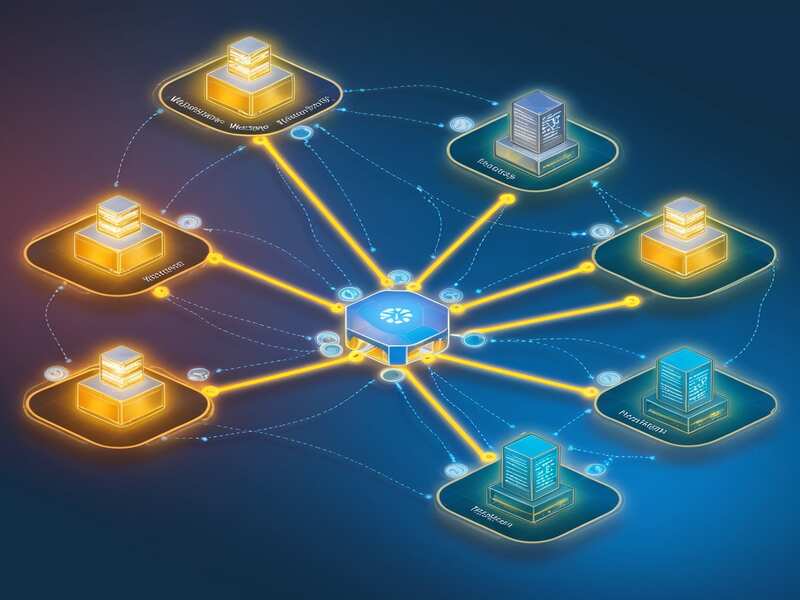What is IBM WebSphere message broker?
Are you looking to understand What is IBM WebSphere Message Broker and how it supports enterprise application integration? Wondering how it handles communication between diverse systems while ensuring smooth data transformation?
In this blog, you will discover how IBM WebSphere Message Broker benefits organisations by optimising message flow, reducing integration complexity, and ensuring that critical data is delivered securely across platforms, all while streamlining complex business application processes.
What is IBM WebSphere message broker?
IBM WebSphere is a messaging platform that allows users to receive and route messages, transform them, and interact with databases and other applications.
It offers various processing nodes for processing messages, allowing for communication with databases, maintenance, and response to events.

The platform also allows for publishing messages, such as for cricket matches, to customers. This functionality is useful for managing customer registration and billing, as well as ensuring that the message is published in the cloud.
Overview of IBM WebSphere message broker
IBM WebSphere is a messaging platform that uses a message broker to manage messages and messages. It is built on top of the queue manager, which stores messages in a queue.
When an application is added to a queue, it is processed by the queue manager. The queue manager handles cumulative data and connectivity, making it easier to edit messages.
A flow is defined in the queue manager and deployed in an integration group. The platform allows users to receive messages from multiple retailers and filters based on retailer location.
IBM Websphere message broker is a tool used to extract information from messages. It has a dot A dot B dot name and notes, which can be overwhelming. The broker comes in the input dominant mode and handles multiple output terminals.
If an exception occurs during recording, it will be cut. If not handled, it will go back to the location and roll back until it finds its own cache.
The starting point is like moving in Java, with Java code on the input. The broker performs invertible transformations on the printing nodes, determining whether to continue the structure or organize changes.
In Java, streams are sent as strings, which are converted into a form of business-like messages. The IBM Websphere message broker converts these streams into XML-based messages.
The conversion process involves a passive process, with multiple passes available for conversion. The parser converts the stream into a logical structure, which is then used by the computer.
The output is then sent to the compute node. Any converted logic must be converted back into the stream, and the parser then converts it back into the stream. This process ensures efficient communication and efficient use of the IBM Websphere message broker.

Evolution of IBM WebSphere Message Broker Architecture
The IBM WebSphere Version 6 architecture included a configuration manager, which was used to define messages for the broker when deploying the configuration manager.
However, in versions 7 and 8, the configuration manager was removed, allowing for direct deployment using an editor.
Version 9 introduced the Share Integration Bus, and local components were designed to handle a logical structure for each message broker, regardless of domain or message format.

IBM WebSphere message broker Training

Properties of IBM WebSphere message broker
The IBM Websphere message broker properties include a route to the head, a pod, and other headers.
The three registered values are crucial for creating a dictionary. In version seven and eight, the model has been made more persistent and prioritized.
The XML namespace is used to search for faster ways to send data, including order names, first and last names, needs, items, and quantities.
The broker can also use the add method to pass blanks according to requirements.
This job involves creating custom messages using IBM Websphere message brokers. These messages are converted from a logical structure, making it easy to add and modify.
The process involves creating a model by reading a data structure and passing method content.
Before adding the structure, the requirements are checked and validated. The broker moves to the next node if it validates, and if not, throws an exception. The process ensures that messages are passed correctly and are easily accessible.

Handling files and headers in IBM WebSphere Message Broker involves generating a broker for all files, which can map between groups and create an external broker.
The logical model T supports MRF but requires in-person support. Teamwork andcommunication are crucial in the development process.
Flow-Level Property Management in IBM WebSphere
IBM Websphere message broker follow a specific order, starting with the body and then properties, followed by the body.
They add properties and MQM based on the flow level and process single messages first in first out.
If the broker is not clear about messages between productions, it must be removed before processing.
Multiple identity paths are available, and they can be deployed at the same point in different workers.
However, the method that comes in a particular instance will only be processed in that instance, not passed to others.
This ensures that messages are processed correctly and efficiently.
Message Processing in WebSphere message broker
Liveaboard notes and radius are messages that a logical structure processor uses to get the value from an expert and send it to an output.
It is easy to write code and one month would be very easy. The IBM Websphere message broker comes with different headers, such as property and PMB headers, and a body that contains editing opportunities.
Each message has an ID, unique ID, and is categorized by time, start time, and application. The first property is set to the description and payload, and the body contains the method being inserted into the table.

IBM WebSphere message broker Online Training

Visualizing the Project Lifecycle in IBM WebSphere Message Broker
The project lifecycle in IBM WebSphere Message Broker involves several key components, including content, domain, and timer nodes.
The project lifecycle begins with the development of Unix components, which follows a step-by-step approach, starting with input mode and progressing through compute nodes.
Effective strategies and subgroups are emphasized to ensure successful project delivery. The development of intellectual understanding and flow of notes plays a critical role in learning and growth.
Error handling is another crucial aspect of the project lifecycle, ensuring seamless processing at any time, even at one o’clock in night.
The development of a production or DNS environment is thoroughly tested and integrated into the development system.
The importance of structure is highlighted across various sectors, including ministry and local environments, where exceptions are handled systematically through flowcharts.

Benefits of IBM WebSphere message broker
The IBM WebSphere message brokertool is designed for small industry inventors and is used for banking. For example, when integrating with online stores, retailers need to communicate with data to communicate with pillar one base.
The tool allows for multiple returns for generic items like electronic laptops.
ThisTwo-way communication systems offer benefits over point-to-point communication, as they reduce the need for multiple individuals to communicate.
It centralizes communication with IBM Websphere, ensuring that everything is handled by the centre.
This reduces the risk of server downtime and improves integrity. Initially, point-to-point communication was used, but changes need to be made on the receiver side.
To improve communication, businesses can transform routes or enrich the process. However, retailers may not want all the information provided, so businesses should only send specific information.
If a retailer requests more information, businesses can cut short messages and send them back.
IBM WebSphere Message Broker is a high-performance integration platform that connects various systems and applications.
Its intuitive visual design interface simplifies the creation and deployment of integration workflows while supporting multiple messaging protocols and transport methods.
This platform offers advanced capabilities such as message transformation, routing, and enhancement, making it ideal for intricate event-driven architectures.
Moreover, it comprises monitoring and management tools that offer real-time analytics and reporting for the integration environment, ensuring dependable and flexible integration.
However, compared to simpler integration tools, it may require a higher level of expertise to implement and manage.

IBM WebSphere message broker Course Price


Gayathri
Author